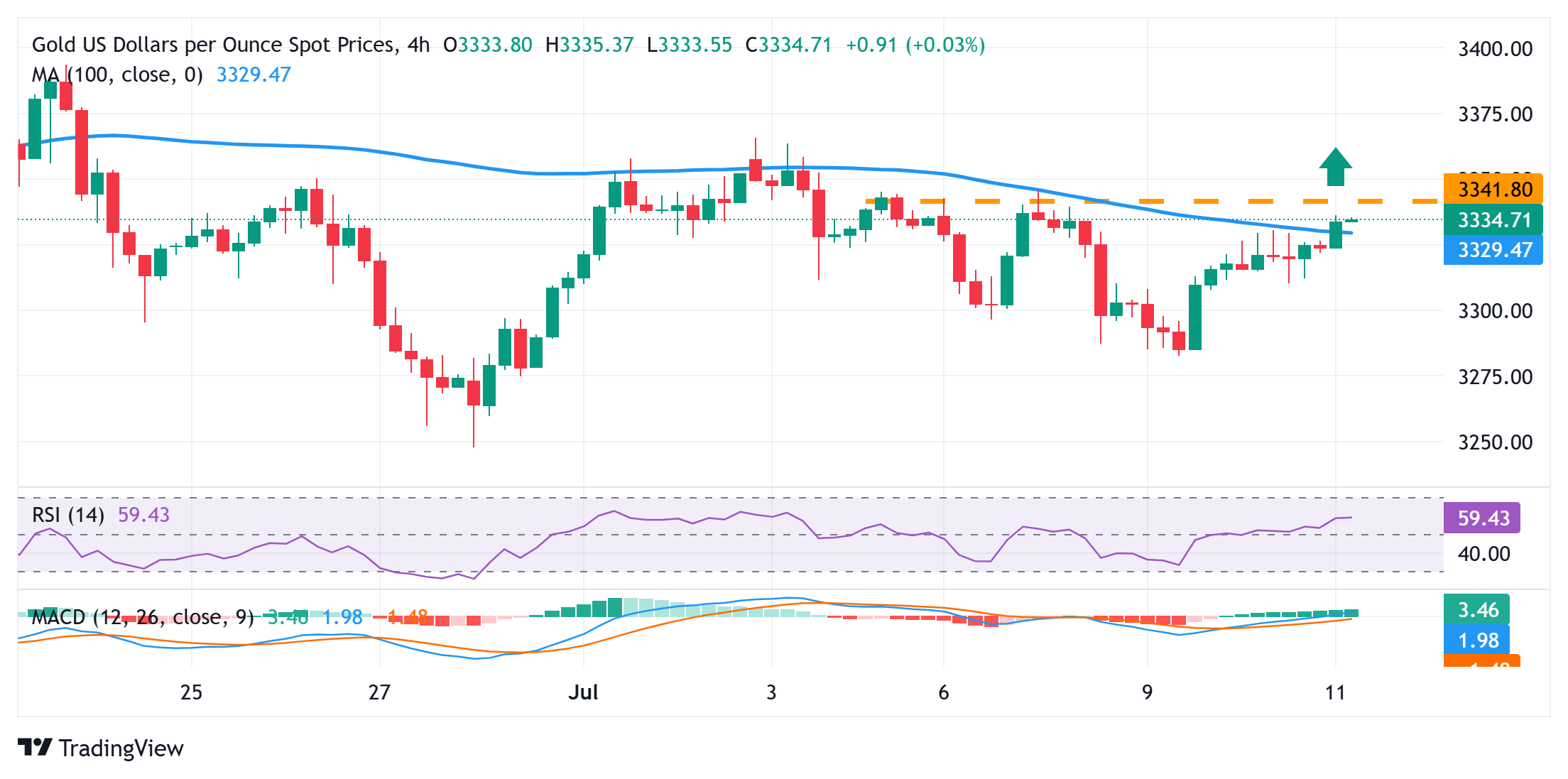- Gold price attracts buyers for the third straight day, though the upside seems limited.
- Rising trade tensions offset a broadly firmer USD and remain supportive of the move.
- Reduced Fed rate cut bets might hold back the XAU/USD bulls from placing fresh bets.
Gold price (XAU/USD) attracts some follow-through buying for the third straight day on Friday and climbs to the top end of its weekly range heading into the European session. In a dramatic escalation of the trade war, US President Donald Trump this week issued notices to a slew of trading partners and raised concerns about a global trade war. This, in turn, is seen as a key factor that continues to drive safe-haven flows towards the precious metal.
Meanwhile, traders have scaled back their bets for an immediate rate cut by the Federal Reserve (Fed) amid expectations that higher tariffs would reignite inflation and a still resilient US labor market. This assists the US Dollar (USD) to stick to its bullish bias near a two-week high and could act as a headwind for the non-yielding Gold price. Hence, it will be prudent to wait for some follow-through buying before positioning for further gains.
Daily Digest Market Movers: Gold price continues to attract safe-haven flows amid rising trade tensions
- US President Donald Trump announced a 35% tariff on Canadian imports, effective August 1. The decision was conveyed in a letter, which marks the latest in a string of over 20 similar tariff notices Trump has issued since Monday. This comes following Wednesday’s announcement of a 50% tariff on US copper imports and continues to drive safe-haven flows towards the Gold price.
- Minutes from the Federal Reserve’s June 17-18 policy meeting showed that most policymakers remain worried about the risk of rising inflationary pressure on the back of Trump’s aggressive trade policies. The Minutes also revealed that only a couple of officials felt interest rates could be reduced as soon as this month, assisting the US Dollar to stand firm near a two-week top set on Thursday.
- On the economic data front, the US Department of Labor (DOL) reported that Initial Jobless Claims fell to 227K for the week ending July 5. This was less than the estimates and the previous month’s downwardly revised reading of 232K. This, along with stronger US employment details released last Thursday, points to a resilient US labor market and signals no urgency for the Fed to cut rates.
- Meanwhile, San Francisco Fed President Mary Daly said that monetary policy is still restrictive, and it’s time to think about adjusting the interest rate. Tariffs aren’t as high as they were expected to be, and economic fundamentals support a move toward lower rates at some point, Daly added further.
- Separately, Fed Board of Governors member Christopher Waller noted that tariff inflation effects are likely to be short-lived and that a rate cut here would not be politically motivated. Waller – one of the possible favorites to replace Powell in 2026 – made another push for an early interest rate cut in July.
- In contrast, St. Louis Fed President Alberto Musalem said that it was too soon to tell if tariffs will have a one-off or a more persistent impact on inflation. The economy is in a good place, and it is critical for the Fed to keep long-term inflation expectations anchored, Musalem added further.
- There isn’t any relevant market-moving economic data due for release from the US on Friday, leaving the USD at the mercy of comments from influential FOMC members. Apart from this, trade-related developments should contribute to providing some impetus to the XAU/USD pair on the last day of the week. At current levels, the commodity remains on track to end the week on a flattish note.
Gold price bulls look to seize control above 100-SMA on H4

From a technical perspective, some follow-through buying beyond the $3,340-3,342 horizontal barrier will confirm a breakout through the 100-period Simple Moving Average (SMA) on the 4-hour chart. This, along with slightly positive oscillators on the said chart, should pave the way for a further near-term appreciating move and lift the Gold price to the next relevant hurdle near the $3,360-3,362 region. The momentum could extend further and allow the XAU/USD pair to reclaim the $3,400 mark.
On the flip side, weakness below the $3,326 immediate support could attract some dip-buyers and help limit the downside for the Gold price near the $3,300 round figure. This is followed by the $3,283-3,282 region, or over a one-week low touched on Tuesday. A convincing break below the latter would make the XAU/USD pair vulnerable to accelerate the fall towards the July swing low, around the $3,248-3,247 area.
Fed FAQs
Monetary policy in the US is shaped by the Federal Reserve (Fed). The Fed has two mandates: to achieve price stability and foster full employment. Its primary tool to achieve these goals is by adjusting interest rates.
When prices are rising too quickly and inflation is above the Fed’s 2% target, it raises interest rates, increasing borrowing costs throughout the economy. This results in a stronger US Dollar (USD) as it makes the US a more attractive place for international investors to park their money.
When inflation falls below 2% or the Unemployment Rate is too high, the Fed may lower interest rates to encourage borrowing, which weighs on the Greenback.
The Federal Reserve (Fed) holds eight policy meetings a year, where the Federal Open Market Committee (FOMC) assesses economic conditions and makes monetary policy decisions.
The FOMC is attended by twelve Fed officials – the seven members of the Board of Governors, the president of the Federal Reserve Bank of New York, and four of the remaining eleven regional Reserve Bank presidents, who serve one-year terms on a rotating basis.
In extreme situations, the Federal Reserve may resort to a policy named Quantitative Easing (QE). QE is the process by which the Fed substantially increases the flow of credit in a stuck financial system.
It is a non-standard policy measure used during crises or when inflation is extremely low. It was the Fed’s weapon of choice during the Great Financial Crisis in 2008. It involves the Fed printing more Dollars and using them to buy high grade bonds from financial institutions. QE usually weakens the US Dollar.
Quantitative tightening (QT) is the reverse process of QE, whereby the Federal Reserve stops buying bonds from financial institutions and does not reinvest the principal from the bonds it holds maturing, to purchase new bonds. It is usually positive for the value of the US Dollar.

